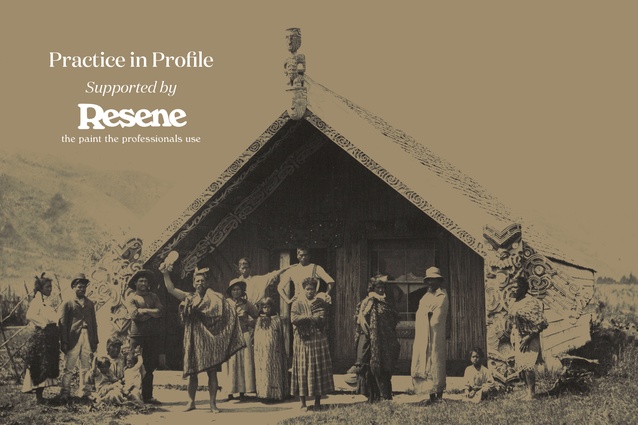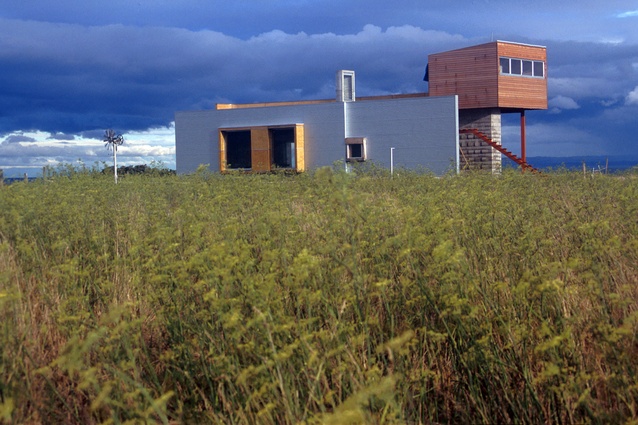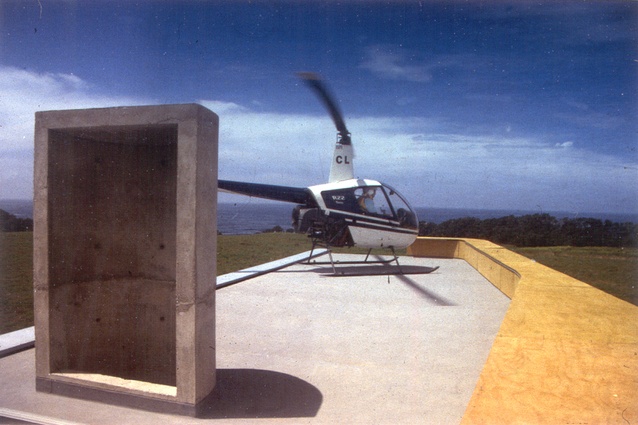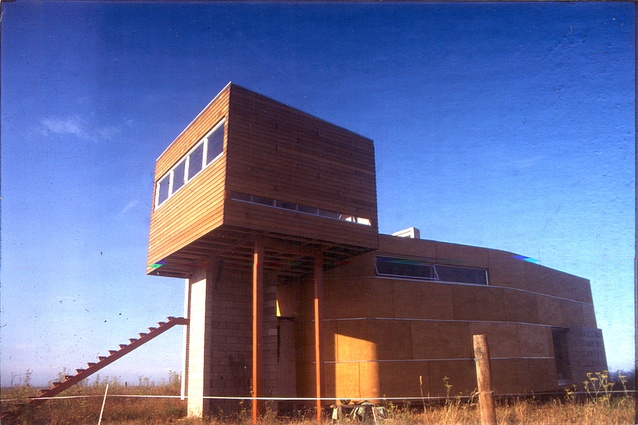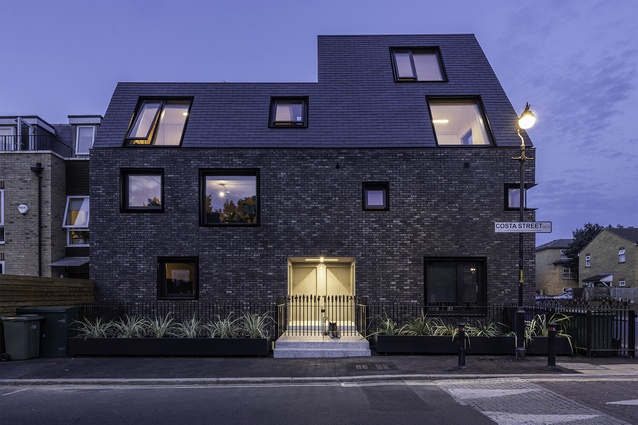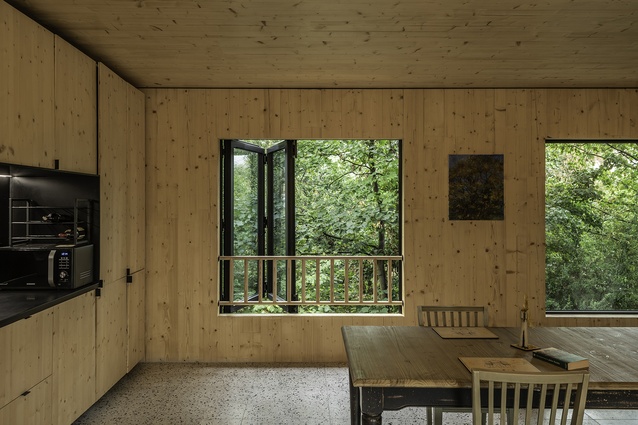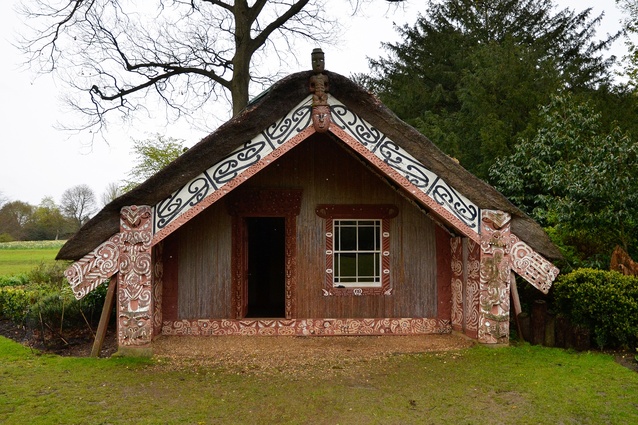Transcolonisation: 1990–2020
Anthony Hoete traces 30 years of the slow road to Te Ao Māori architecture in Aotearoa and the quest for this emergent architecture on these islands to reconcile colonial traditions and European influences with a sustained interest in the indigenous project.
This article allows me to calibrate my relationship to the architecture of Aotearoa New Zealand between 1990 and 2020 via flashbacks and ‘Fast Forwards’. Many architectural epochs don’t last 30 years (futurism 1909–1934, brutalism 1950–1978, metabolism 1959–1968,1 deconstructivism 1982–2008)2 and so this time in absentia is long enough to ‘sea change’.
When I departed these shores, New Zealand was completing its sesquicentennial year commemorating 150 years since Te Tiriti’s signing and interest in things Māori was high. The term ‘bicultural’ had entered local architectural discourse, with Russell Withers first to deploy it in his 1986 column on Racism and Architecture.3 The second reference, in 1987, was by Rewi Thompson about his work reflecting the “balance between things Māori and Pākehā”.4
Cultural interactions were becoming more critical in institutional building designers’ work.5 By the time Jasmax won the international competition to design the Museum of New Zealand Te Papa Tongarewa, that design “biculturally cleaved the building into tangata whenua and tangata tiriti (non-Māori) areas”.6
Let’s rewind a little further.
When I left Kawerau College for the University of Auckland in the mid-’80s, there was no such ‘thing’ as Māori architecture. The architecture routinely being taught in the university’s curriculum was a foreign variant. During my studies at the School of Architecture and, later, for two years at the School of Engineering (Civil), all my pedagogical references were European in their authorship (Tafuri, Foucault, Derrida…) or Western in their canon (modernism, regionalism, postmodernism…). The vocabulary heard in the studio was more palimpsest, less papakāinga, more mimesis, less mātauranga, and more a priori, less Te Ao Māori. Although there was significant research into South Pacific architecture by Mike Austin7 and Michael Linzey8, this learning was optional. There was no core allocation in the curriculum for any indigenous reading of architecture.
Sometimes, we do not recognise the value of our cultural production until others applaud it. I witnessed this at La Biennale di Venezia 1991, with the Auckland School’s exhibition, ‘Architecture to a Fault’, where a superlative installation intertwined the architectonic codes of European NZS 3604 timber framing with Micronesian mapping. The team ‘from the margins’9 won the Venice Prize, and this was an empowering first foreign signal to me that South Pacific architecture could contribute to the world stage.
Or so I thought at the time.
Following the success of Auckland beating 43 other schools, it surprisingly took another 23 years before New Zealand found the funds to stage its inaugural national exhibition at Biennale 2014. Curator David Mitchell believed that the South Pacific’s unsung architecture had become more distinctive in New Zealand as England’s influence waned. It is the indigenous project (people, land, nature) that renders this nation unique and it is Te Ao Māori that can unpack the narrative of the architecture of Aotearoa New Zealand. The Venice Biennale was and still is the world’s largest architectural tournament. Aotearoa New Zealand will not be represented amongst the 110 invited practices or 63 national pavilions participating in the 2021 edition (although Auckland’s School of Architecture and Planning’s ‘Learning from Trees’ timber technology project will be present).
Sadly, early success hasn’t produced a sustained legacy, which is unfortunate, given the relevance to Aotearoa New Zealand of curator Hashim Sarkis’ forthcoming Biennale theme: How Will We Live Together? Was ‘Architecture to a Fault’ merely the semiotic framing of biculturalism buoyed by an architecture of good intentions,10 with sesquicentennial euphoria propelling on-point signage and symbolism? Or was it, in hindsight, the false dawn of biculturalism and, therefore, ‘architecture at fault’? When will the architecture of Aotearoa New Zealand reconcile colonial traditions and European influences with a sustained interest in the indigenous project? The exhibition text from 30 years ago alluded to the myth of Māui and “fault lines in our culture, language, and architecture”. One might have thought that faults in our architectural culture’s language would have been attended to within three decades.
In drawing on fault lines, we were merely papering over cracks.
Today, only one architecture school offers Māori core curriculum content,11 with all others failing Te Tiriti obligations. No seismic shift has occurred and the education on offer in Aotearoa is not specific to the South Pacific. Lynda Simmons recently looked forward12 to a time when architectural students could move between Māori and Pākehā systems of parallel learning. Is the next generation of architectural practice still being contextually misaligned? Why is the architecture of Aotearoa New Zealand plotting a divergent course from that of society? In 2020, just 10 per cent of our economic trade was with the EU while 63 per cent was with East Asia and the Pacific.13 With disregard for current relationships, we still ply our architectural trade with a European import bias.
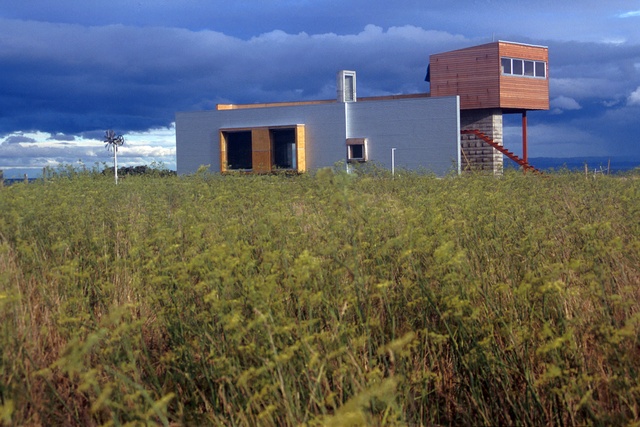
In 1995, I was studying at The Bartlett, attracted by a cohort of celebrity architects. Peter Cook, Enric Miralles, Daniel Libeskind and Neil Denari were my design tutors, and the course had a very Western avant-garde discourse. As I neared completion, I heard a karanga, a call from home with an opportunity to return, reflect upon European pedagogy and engage in mātauranga Māori through a papakāinga.
My father was retiring and returning: leaving Tasman Pulp and Paper Mill at Kawerau for his tūrangawaewae of Mōtītī Island. This place is best understood through the lens of Rewi: “the land is not just a surface, nor the sea a boundary, nor the sky a backdrop”.14 The call was to build a whare on ancestral land: an ahi kā, a means to keep the home fires burning, signifying occupation, claim and use15 with further poignancy given by the meaning of Mōtītī as extirpated, or localised extinction.16
The call was to build a whare, not just design it, because Māori did not employ architects. Nor builders. One did not have the money. And so, Aunt Kathy worked the concrete mixer; Uncle Graham shunted the cement to the shuttering in a wheelbarrow. The cement consisted of a sand-stone mix that my father, Aubrey, had sifted and shifted using a bread tray down on the nearby tractor-accessed beach. The whānau’s involvement reinforced the notion that, for Māori, architecture ceases to exist without mana whenua involvement. Like a traditional whare, this whare is a one-roomed building. We eschewed all the ancillary trappings of domesticity typically found on the mainland: en suites, kitchen islands, garaging, lap pools. For a house to have social value, it must focus on having spiritual, political and cultural significance to a specific community: the whare tūpuna is such a house. Māori architecture inextricably ties one to the land upon which one lives.
As the international juror on the 2020 NZIA National Awards Tour, I was made aware that the architecture of Aotearoa New Zealand coagulates around not housing but the house. Invariably, this is a 300+sqm bloated bach or conflated second home rented out on Airbnb. Don’t blame the architect for accepting the commission – practice is primarily a game of survival that pivots to our rampant neoliberal housing market.
Britain introduced a capital gains tax in 1965 and stamp duty land tax in 2003 – is greater regulation required for greater equity? Otherwise, future generations of homebuyers will need the Bank of Mum and Dad for deposits ad infinitum. Recent changes to the bright-line test suggest that this is now a capital gains tax in all but name.17 Income, interest and tax are, however, fiscal, not architectural, tools for housing affordability.
Practice will increasingly engage in the design of housing rather than the house. This means optimal development densities based on a more granular metric of habitable rooms per hectare, greater diversity of type and size, more-efficient floor areas, more inclusivity in public-private tenure and embracing new offsite prefabrication technologies, such as cross-laminated timber (CLT). All of which are strategies I engaged in while playing an expanded form of architectural practice: designer-builder with WHAT_architecture and developer with Game of Architecture (see Costa Street project in Peckham).
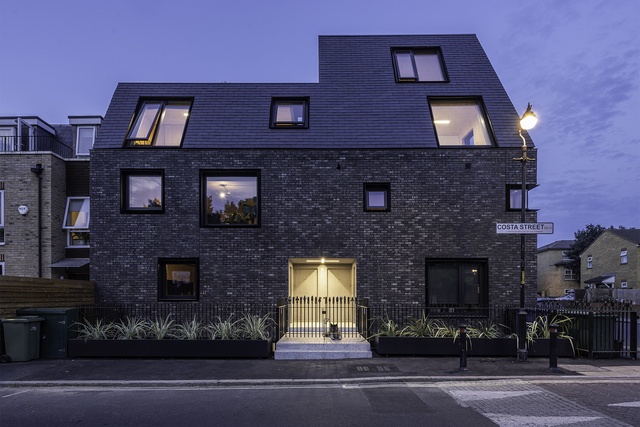
Māori housing also needs specific financing, planning, design and building frameworks to address the societal imbalance. Alienation, confiscation and enforced Crown purchase have left 17 per cent of the population (Māori) with just 6 per cent of the land. Land with unique issues, such as multiple ownership, problematising land as security. Papakāinga would benefit from the creation of an Iwi Bank to unlock finance. The design requirements would be different, given a larger number of inhabitants on disproportionately lower incomes, living intergenerationally in the same dwelling.
These constraints could give rise to innovation with, say, courtyard and vertical papakāinga. Iwi-owned forests could provide the manufacturing basis for CLT factories, disrupt supply chains, build costs and increase housing affordability. By developing ferry networks, we can also turn the Hauraki Gulf into the waka highway, last seen in pre-contact times when Māori ferried obsidian from the Bay of Plenty to the Bay of Islands.
Thirty years after its introduction, the Resource Management Act 1991 is potentially being replaced by three Acts, including the Natural and Built Environments Act. Will its new National Planning Framework (which sounds remarkably similar in name to the UK’s NPPF of 2012) better accommodate the 87 per cent who live in the cities and towns of Aotearoa New Zealand, the world’s 28th most urbanised country? Early readings suggest no impact on (Auckland’s) housing affordability with, for example, intensification around transit nodes and zoning already covered by existing national policy statements. The biggest question regarding the changes instead revolves around resource consent determination: who will decide and how?
In 2007, I heard a second karanga concerning a whare, this time regarding Hinemihi o te ao tawhito in Surrey. Shopped and shipped to the UK after the Tarawera eruption in 1886 by the Governor of New Zealand, William Hillier, Fourth Earl of Onslow, Hinemihi was the house-as-souvenir. Speculation as to the legitimacy of the transaction was countered by Britain’s largest private property owner, the five-million-member National Trust, exhibiting a Bill of Sale until the Clandon Park House fire of 2015. The impoverishment of post-New Zealand War Māori at the time would have distorted any idea of a ‘willing buyer, willing seller.’ The asymmetry of the relations between coloniser and colonized18 saw one economic and political power appropriate and commodify another’s cultural forms.19
Over the following century, Hinemihi was effectively culturally demoted from the whare tūpuna (ancestral house) to whare whakairo (carved house), Wendy house, goat house, boathouse, folly and gnome.20 The misconstrual of living heritage as an inanimate art object hastened physical deterioration of the whare and suspicions of systemic racism. The voluntary service I gave to Te Maru O Hinemihi required nine years of chairmanship due to the National Trust’s institutional procrastination. Communications with the New Zealand Prime Minister’s office were needed to entice the UK statutory authorities to the negotiating table. A pānui asked to exchange Hinemihi’s carvings for a new pan-iwi, co-designed whare for export from New Zealand. Te hokinga (the return) of Hinemihi to Aotearoa New Zealand is an object lesson that the Māori architect also needs to be a navigator-negotiator. This role is not found in the NZIA Agreement for Architects Services AAS 2018 Standard Form and is another example of expansive architectural practice.

In 2020, I heard a (third) karanga, this time from the whare Te Pare (School of Architecture and Planning), which brought me home.
I have heard te reo Māori or, rather, kupu Māori, being spoken more often with the improved pronunciation of place names. Although te reo has been an official language since 1987, its learning rates are still in decline and urgently need arresting. Otherwise, te reo is on a pathway towards extinction.21 It is surprising, then, that the Broadcasting Standards Authority decided only this month to cease taking public complaints about the use of te reo on air and screen. One might have thought the bicultural impetus from 1990 might have kickstarted bilingualism before 2021. To lose a language is to lose culture and identity. The failings of bilingualism mirror those of biculturalism, meaning that Māori adaptation to, or negotiation with, Pākehā colonisation has been a strictly one-way affair.22
In the light of the Black Lives Matter movement, the need to understand the ways in which architecture interacts with race and culture is, again, in the spotlight. Organisations like the Association of Collegiate Schools of Architecture in the US,23 King’s College in the UK24 and the newly formed African Futures Initiative in Ghana focus on indigenous-led teaching as education today flows into practice tomorrow. Much mahi has been done in New Zealand, including Te Aranga Design Principles (2nd edition, 2008), Te Mana Raraunga Charter for Māori Data Sovereignty (2016) and Te Kawenata o Rata agreement between the NZIA and Ngā Aho (2017).
Since Wiremu Royal became the first Māori to register as an architect in New Zealand in 1957, there has been a flourishing of contemporary indigenous-led practices. My classmates were Rau Hoskins of designTRIBE, Albert L. Refiti, and Huia Reriti of +MAP. Today, they are consolidated by ĀKAU, TOA Architects, Waka Māia and Kaiāwhina at Jasmax, Te Matakīrea at Warren and Mahoney, Matakohe Architecture + Urbanism, MAU Studio and New Pacific Architecture. More recently, Matekitātahi Rawiri-McDonald wrote his thesis in te reo and Ben Tunui won the NZIA 2020 Student Design Award. As significantly, Pākehā practices like Pattersons (website signposted in te reo) and Tennent Brown are realigning to Te Ao Māori as the new norm.25 These are good signals for the indigenisation of the architecture of Aotearoa New Zealand.
To this end, I am ‘culturating’ the lecture series >>FFWD21, which fast-forwards Aotearoa New Zealand from the time of Te Ao Māori Tawhito to a place of Transcolonisation. In the first talk, gallerist Tim Melville and Toi Tū Toi Ora’s curator, artist Nigel Borell, asked: Who controls Māori art? Consider that there has been no director of the Auckland Art Gallery from Aotearoa New Zealand for more than 30 years.26 Many New Zealand organisations and institutions operate under foreign directorship – ought we be less enamoured with internationalism and more demanding of localised competencies? Other presenters include: Jacinta Ruru, whose research on legal personality could innovate the worlds of building, marae and heritage conservation; Witi Ihimaera, who speculates on the ways in which Māori mythology could drive architectural narratives; and Paul Majurey, who chairs the Tūpuna Maunga O Tāmaki Makaurau Authority. Transcolonisation is the transformative indigenous project which imagines a better built environment – for us all – in Aotearoa New Zealand.
Visit fastforward.ac.nz for more information about the upcoming talks in the 2021 Fast Forward lecture series.
1 en.wikipedia.org/wiki/Timeline_of_architectural_styles
2 theguardian.com/news/2004/oct/11/guardianobituaries.france
3 Christine McCarthy, ‘Bicultural architecture’, AHA: Architectural History Aotearoa, 2009, volume 6, p. 26.
4 Christine McCarthy, citing Rewi Thompson, in New Zealand Architect, 1987, volume 1, issue 15, pp. 18–19.
5 Deidre Brown, Māori Architecture: From fale to wharenui and beyond, Raupo (Penguin) Publishing, 2009, p. 146.
6 wgtn.ac.nz/__data/assets/pdf_file/0006/1886766/NZ-Architecture-1990s-Call-for-Papers.pdf
7 Mike Austin, ‘Notes on the colonial city’, Fabrications, December 1991, 2/3, pp. 35–44.
8 Michael Linzey, ‘Speaking to and talking about: Māori architecture’, Interstices: Journal of Architecture and Related Arts, 1990, pp. 50–61. doi.org/10.24135/ijara.v0i0.24
9 Michael Linzey, ‘The Venice Prize’, Interstices, 1992, 2, p. 189.
10 Colin Rowe, The Architecture of Good Intentions, Academy Editions, 1994. Rowe slates the architect’s fatal flaw as being to stipulate an intrinsic connection between form and the condition of society.
11 aut.ac.nz/study/study-options/architecture-and-built-environment/courses/master-of-architecture-professional
12 architecturenow.co.nz/articles/opinion-parallel-education-systems/
13 wits.worldbank.org/CountryProfile/en/Country/NZL/Year/2018/TradeFlow/EXPIMP/Partner/by-region
14 Deidre Brown, architecturenow.co.nz/articles/obituary-rewi-thompson/
15 teara.govt.nz/en/take-whenua-maori-land-tenure/page-4
16 Vincent O’Malley, Mōtītī Island: Customary Interests and Crown Engagement, report for the Waitangi Tribunal, March 2018, p. 3.
17 thespinoff.co.nz/politics/26-03-2021/did-labour-just-create-a-back-door-capital-gains-tax-the-experts-weigh-in/
18 Coloniser: British spelling; colonized: non-British spelling.
19 Dean Sully and Alan Gallop, ‘Introducing Hinemihi’, in Dean Sully (ed.) Decolonising Conservation, Routledge, 2007, p. 127.
20 Michael Upchurch, ‘Hinemihi o te Ao Tawhito: How a Māori Meeting House in England cultivated relationships and understanding’, Museum Worlds 8(1), July 2020, pp. 188–203.
21 royalsociety publishing.org/doi/10.1098/rsif.2019.0526
22 Christine McCarthy, Bicultural architecture, AHA: Architectural History Aotearoa, 2009, volume 6, pp. 21–32.
23 acsa-arch.org/resources/data-resources/where-are-my-people-asian-american-native-hawaiian-and-pacific-islander-in-architecture/
24 timeshighereducation.com/news/london-university-develops-indigenous-led-teaching-and-research
25 stuff.co.nz/life-style/homed/latest/123630216/maori-and-pasifika-architects-pioneering-a-new-norm
26 aucklandartgallery.com/about/history-and-collection/directors

